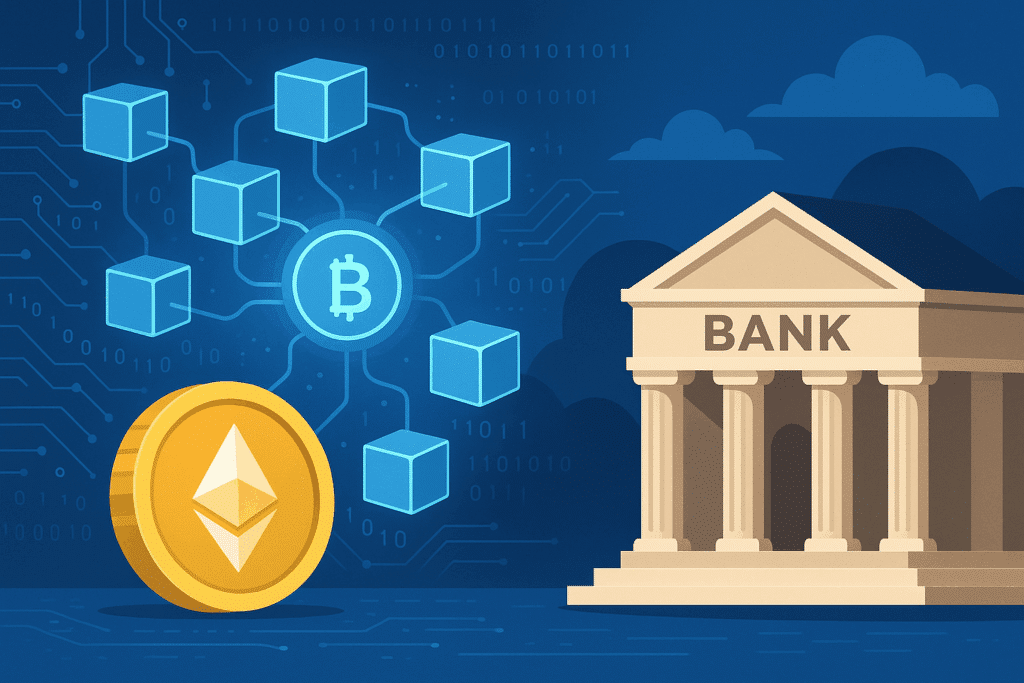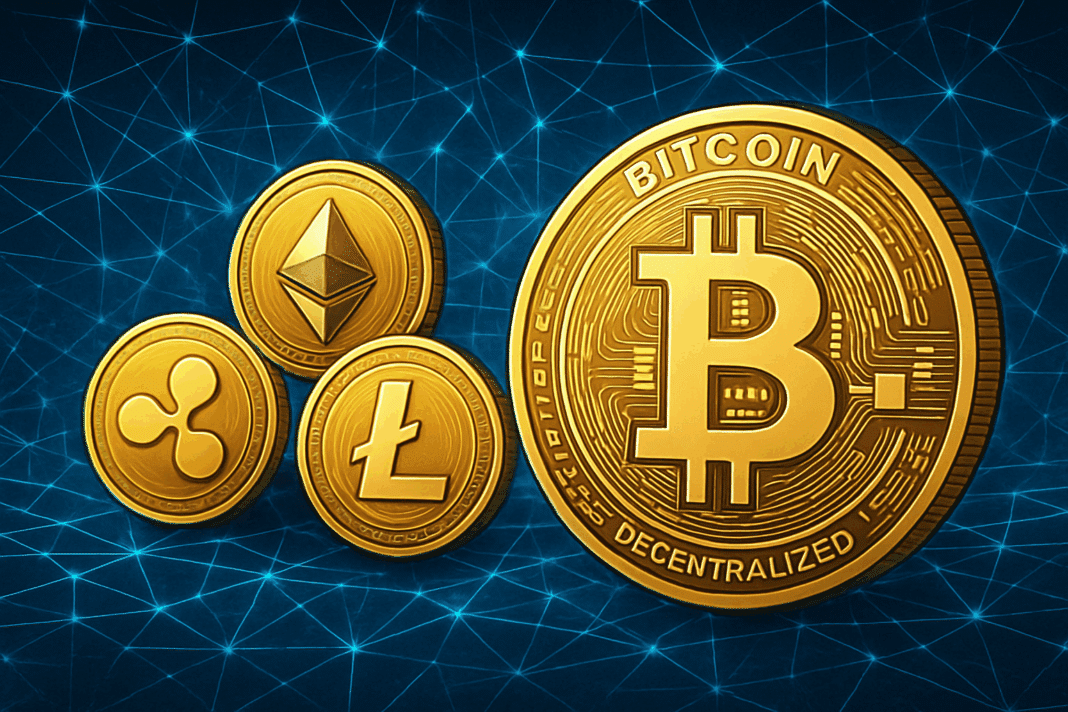Decentralized Finance Explained: Why DeFi Could Replace Banks
Decentralized finance (DeFi) is a blockchain-based financial system that removes banks and middlemen, enabling peer-to-peer transactions. Decentralized finance uses smart contracts to automate lending, trading, and payments on distributed ledgers. By eliminating intermediaries, DeFi platforms promise lower fees, faster transfers, and global access. This article explains why DeFi could compete with or even replace traditional banking, exploring its benefits, how it works, and its challenges.
What is Decentralized Finance (DeFi)?
Decentralized finance (DeFi) refers to financial services built on blockchain that operate without central intermediaries. Unlike traditional banking, DeFi is âa broad range of financial applications in blockchain aimed at disrupting financial intermediariesâ. It uses open-source smart contracts (self-executing code) to automate loans, insurance, and exchanges. This means you can borrow, lend or trade directly with others, controlling your assets without a bank. Essentially, DeFi platforms (like Aave or Uniswap) let users be their own bank, handling deposits and trades via blockchain.
How DeFi Works: Smart Contracts and Platforms
DeFi platforms run on blockchain networks (mostly Ethereum). Smart contracts are programs that automatically execute when conditions are met. For example, you deposit crypto into a lending pool smart contract, and it automatically allocates interest, all without human involvement. This automation enhances transparency and security. Common DeFi components include decentralized exchanges (DEXs) for crypto trading, lending protocols, and yield-farming platforms. Anyone can participate 24/7 globally: as OSL reports, DeFi âoperates around the clock, unlike traditional banksâ and offers âhigher yieldsâ on assets. In short, blockchain and code replace bankers and paperwork.
Benefits of DeFi: Financial Freedom and Access
DeFi has several key advantages. Without banks, transaction costs drop and services are accessible to anyone with internet. For example, lending rates on DeFi can be much higher than bank savings. DeFi products often allow passive income generation (staking or yield farming). As one source notes, DeFi offers âhigher yieldsâ and âglobal accessibilityâ for users. It also democratizes finance: traditional banks exclude many people, but DeFi is open to underbanked populations. Indeed, proponents say DeFi can empower those without bank accounts by providing basic finance tools via crypto. This could truly advance financial freedom.
DeFi vs Traditional Banks
DeFi can potentially replace or complement banks. Both systems perform similar roles: storing value, facilitating payments, and providing credit. But DeFi does so peer-to-peer. By cutting out intermediaries, DeFi may reduce fees and delays. For instance, cross-border transfers can be instant and cheap on DeFi. Moreover, DeFi is transparent: transactions are public on the blockchain, reducing fraud and errors. Traditional banks, meanwhile, offer stability, insurance, and legal protections that DeFi currently lacks. A key quote highlights DeFiâs promise: it âdisrupts traditional banksâ by handling financial services without a central authority. However, many experts foresee a hybrid future where banks adopt DeFi tech.
Challenges and Risks of DeFi
Despite its promise, DeFi has hurdles. Security is a major concern: code bugs have led to hacks of billions of dollars. Since âDeFi operates in a trustless environmentâ, any flaw is exploitable. Regulatory uncertainty is also significant: many DeFi services run outside existing laws, so governments may impose rules or crack down. Moreover, the learning curve is steep; many people find DeFiâs complexities (private keys, wallets) daunting. As an analyst notes, while DeFi is âcheaperâ and âmore democratic,â it canât reach everyone â those without tech access or knowledge could be left behind. Stability and consumer protection (like banksâ deposit insurance) are also lacking in DeFi.

The Future of DeFi and Banking
Can DeFi replace banks? It might not eliminate banks overnight, but it will shape finance. Big financial players are experimenting with DeFi. Some foresee banks integrating blockchain services, or governments issuing digital currencies (CBDCs). As one expert observes, âDeFi is comingâ and traditional finance will adapt. In any case, DeFiâs rise pushes for more innovation, driving financial freedom. It also highlights the demand for decentralized solutions; with improvements (security, regulation), DeFi could rival banks in many areas. The future likely holds a hybrid system where traditional and decentralized finance coexist, offering consumers more choices.
Mini-FAQ
- Q: What is decentralized finance?
A: Decentralized finance (DeFi) is a blockchain-based system for financial services without banks, using smart contracts for lending, trading, and more. - Q: How does DeFi differ from banks?
A: DeFi removes middlemen. Transactions happen peer-to-peer on blockchain. Unlike banks, DeFi works 24/7 globally and lets users keep full control of their crypto assets. - Q: Are DeFi platforms safe?
A: DeFi can be risky due to hacks and code bugs. Users must secure keys and understand protocols. Unlike banks, there is no official insurance, so âevaluate risks carefullyâ is key. - Q: What is a smart contract?
A: A smart contract is code on the blockchain that executes transactions automatically when conditions are met. DeFi uses them instead of bank employees. - Q: Can ordinary people use DeFi?
A: Yes, anyone with internet and crypto can use DeFi platforms. However, it requires digital wallets and some technical know-how.
Conclusion
DeFi is redefining finance with blockchain innovation. By eliminating traditional intermediaries, decentralized finance offers lower costs, higher yields, and global access. While banks have built-in stability and oversight, DeFi provides unprecedented financial freedom. The two systems may coexist: banks could adopt DeFi elements, and regulations will evolve. Ultimately, DeFiâs growth demonstrates that many banking services can be delivered via blockchain finance and crypto banking solutions. As one analyst put it, DeFiâs momentum is undeniable, and it will continue to influence how we manage money.
Further Reading
- Ethereum Foundation â Decentralized Finance (DeFi) Overview
A primer on how smart contracts and Ethereum power most DeFi applications.
đ ethereum.org - World Economic Forum: DeFi Beyond the Hype
Analysis of opportunities, risks, and the potential of decentralized finance.
đ weforum.org - Boston Federal Reserve: The Risks and Promise of DeFi
Research exploring financial stability, regulation, and systemic implications.
đ bostonfed.org - CoinDesk â What is DeFi?
An accessible guide with real-world examples of platforms like Uniswap and Aave.
đ coindesk.com - Chainalysis â DeFi Adoption and Trends
Data-driven insights into global usage, investment flows, and security risks.
đ chainalysis.com

